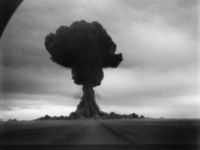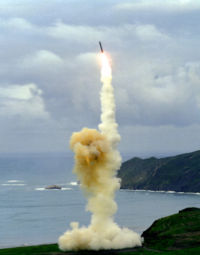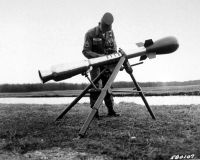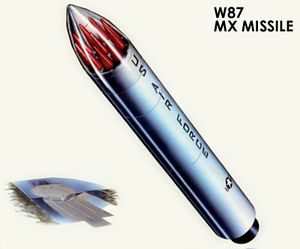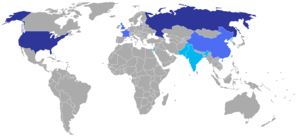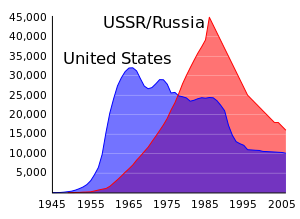سلاح نووي
| الأسلحة النووية |
|---|
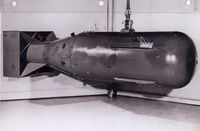 |
| خلفية |
| الدول المسلحة نووياً |
|
السلاح النووي (إنگليزية: nuclear weapon)، أو القنبلة النووية، القنبلة الذرية، أو المقذوفة النووية)، هو سلاح يعتمد في قوته التدميرية على عملية الانشطار النووي؛ ونتيجة لعملية الانشطار هذه تكون قوة انفجار قنبلة نووية صغيرة أكبر بكثير من قوة انفجار أضخم القنابل التقليدية حيث إن بإمكان قنبلة نووية واحدة تدمير أو إلحاق أضرار فادحة بمدينة بكاملها. فُجرت أول قنبلة نووية للاختبار في 16 يوليو 1945 في منطقة تدعى صحراء ألاموغوردو Alamogordo تقع في ولاية نيو مكسيكو New Mexico في الولايات المتحدة وسميت القنبلة باسم القنبلة (أ) A-bomb وكان هذا الاختبار بمثابة ثورة في عالم المواد المتفجرة التي كانت قبل اختراع القنبلة النووية تعتمد في قوتها على الاحتراق السريع لمواد كيميائية الذي يؤدي إلى نشوء طاقة معتمدة فقط على الإلكترونات الموجودة في المدار الخارجي للذرة؛ على عكس القنبلة النووية التي تستمد طاقتها من نواة الذرة مستندة على عملية الإنشطار النووي وبهذه العملية فإن شكلاً دائرياً صغيراً بحجم كف اليد يمكن أن يسبب انفجاراً تصل قوته إلى قوة انفجار يحدثه 20,000 طن من مادة تي إن تي.
القنبلة (أ) A-bomb تم تطويرها وتصنيعها واختبارها من قبل ما سمي بمشروع مانهاتن Manhattan Project التي كانت عبارة عن مؤسسة أمريكية ضخمة تشكلت في عام 1942 في خضم الحرب العالمية الثانية وكان المشروع يضم أبرز علماء الفيزياء في الولايات المتحدة مثل أنريكو فيرمي Enrico Fermi و روبرت اوپنهايمر J. Robert Oppenheimer والكيميائي هارولد أوري Harold Urey. بعد الحرب العالمية الثانية قامت هيئة الطاقة النووية في الولايات المتحدة بإجراء أبحاث على القنابل الهيدروجينية وتدريجيا بدأ إنتاج قنابل نووية أصغر حجما بكثير من القنابل النووية الأولية التي كانت ضخمة الحجم وبدأت عملية تركيب رؤوس نووية على الصواريخ التقليدية التي يمكن إطلاقها من على منصات متحركة أو من على سطح البحر وحتى من تحت أعماق المحيطات.
اُستُعمِلَت القنبلة الذرية مرتين في تاريخ الحروب؛ وكانتا كلتاهما أثناء الحرب العالمية الثانية عندما قامت الولايات المتحدة بإسقاط قنبلة ذرية على مدينة هيروشيما في 6 اغسطس 1945 وقنبلة ذرية أخرى على مدينة ناگاساكي بعد 3 أيام، أي في 9 اغسطس 1945 وكلا المدينتين تقعان في اليابان. وقد أدى إسقاط هاتين القنبلتين إلى قتل 120,000 شخص في نفس اللحظة، ومايقارب ضعف هذا العدد بعد سنوات. وكانت الأغلبية العظمى من الضحايا في هذين المدينتين من المدنيين. انتقدت الكثير من الدول الضربة النووية على هيروشيما و ناكاساكي إلا أن الولايات المتحدة ارتأت أنها أحسن طريقة لتجنب أعداد أكبر من القتلى إن استمرت الحرب العالمية الثانية فترة أطول.
بعد الضربة النووية على هيروشيما و ناكاساكي وحتى وقتنا الحاضر؛ وقع مايقارب 2000 انفجارا نوويا كانت بمجملها انفجارات تجريبية واختبارات قامت بها الدول السبع التي أعلنت عن امتلاكها لأسلحة نووية وهي الولايات المتحدة والاتحاد السوفيتي (روسيا حالياً) وفرنسا والمملكة المتحدة والصين وباكستان والهند. هناك عدد من الدول التي قد تمتلك اسلحة نووية ولكنها لم تعلن عنها مثل إسرائيل وكوريا الشمالية واوكرانيا، واتُهِمَت إيران مؤخراً من قبل عدد من الحكومات بأنها إحدى الدول ذات القدرة النووية. يُستخدم السلاح النووي في وقتنا الحاضر كوسيلة ضغط سياسية وكوسيلة دفاعية استراتيجية، وتستعمل القدرة النووية أيضا استعمالات غير عسكرية للطاقة النووية.
يمكن لجهاز نووي لا يزيد حجمه عن قنبلة تقليدية أن يدمر مدينة بأكملها عن طريق الانفجار والنار و الإشعاع. نظرًا لأنها أسلحة دمار شامل، فإن انتشار الأسلحة النووية هو محور سياسة العلاقات الدولية. تم نشر الأسلحة النووية مرتين في الحرب، من جانب الولايات المتحدة على مدينتي هيروشيما وناگاساكي في عام 1945 خلال الحرب العالمية الثانية.
. . . . . . . . . . . . . . . . . . . . . . . . . . . . . . . . . . . . . . . . . . . . . . . . . . . . . . . . . . . . . . . . . . . . . . . . . . . . . . . . . . . . . . . . . . . . . . . . . . . . . . . . . . . . . . . . . . . . . . . . . . . . . . . . . . . . . . . . . . . . . . . . . . . . . . . . . . . . . . . . . . . . . . . .
تاريخ الأسلحة النووية
تم استخدام الأسلحة النووية مرتين فقط في الحرب، وكانت الولايات المتحدة هي من استخدمتها ضد اليابان قرب نهاية الحرب العالمية الثانية. في 6 أغسطس 1945، استخدمت جيش الولايات المتحدة قنبلة انشطارية تستمد قوتها من اليورانيوم والمعروفة باسم "الولد الصغير" فوق مدينة هيروشيما؛ بعد ثلاثة أيام، في 9 أغسطس، ألقت القوات الجوية للجيش الأمريكي قنبلة انشطارية ذات نواة پلوتونيوم عرفت باسم "الرجل البدين (قنبلة)الرجل البدين" فوق مدينة ناگاساكي. تسببت هذه القنابل في وقوع إصابات أسفرت عن مقتل ما يقرب من 200000 مدني وأفراد عسكريين.[1] أخلاقيات هذه التفجيرات ودورها في استسلام اليابان محل جدل.
أثناء الحرب الباردة
بعد انتهاء الحرب العالمية الثانية استمرت الولايات المتحدة في تطوير قدراتها النووية وركزت في السنوات الأولى بعد الحرب على تطوير طائراتها من نوع Convair B-36 ليكون بمقدورها حمل قنابل نووية أشد قوة. في 29 اغسطس 1949 قام الاتحاد السوفيتي لأول مرة بتفجير تجريبى لقنبلة نووية في منطقة سيمي بالاتنسك الواقعة في كازاخستان وكانت هذه مفاجئة للولايات المتحدة التي لم تتصور أن السوفييت سيتمكنون من بناء ترسانة نووية بهذه السرعة؛ علماً بأن العلماء في مشروع مانهاتن كانوا قد حذروا البيت الأبيض من أن الاتحاد السوفيتى سيتمكن مستقبلا من تصنيع الأسلحة النووية. هناك مزاعم بأن المخابرات السوفيتية تمكنت من الحصول على الخطوط العريضة لتصميم الأسلحة النووية التجميعية وكانت القنبلة الأولى عبارة عن نسخة مشابهة جدا من قنابل الإنشطار ذات الانضغاط الداخلي التي أُلقِيَت على ناكاساكي.
بدأ التوتر يسود البيت الأبيض الذي قرر تحويل مسؤولية الإشراف على الأسلحة النووية من الجيش الأمريكي إلى لجنة خاصة سُميت؛ لجنة الطاقة الذرية تحسباً لقرارات فردية قد تتخذها قيادات الجيش لاستعمال الأسلحة النووية. وبدأت بعد ذلك في نشر التسلح النووي، فقامت الولايات المتحدة بدعم بعض الحكومات الأوروبية الغربية الموالية لها بإمكانيات صنع ترسانة نووية، وقامت المملكة المتحدة بأول تفجير اختباري في عام 1952، وتلتها فرنسا في عام 1960. بالرغم من أن ترسانة المملكة المتحدة و فرنسا كانت أصغر من ترسانة الاتحاد السوفيتي إلا أن قربهما جغرافيا من الاتحاد السوفيتي كان عاملا استراتيجيا مهما في الحرب الباردة.
بدأ شوط جديد من نشر الأسلحة النووية كوسيلة للدفاع الاستراتيجي في الحرب الباردة في مايو 1957 عندما نجح الاتحاد السوفيتي في تصنيع صواريخ ذات رؤوس نووية عابرة للقارات مما اثار فزعا في صفوف الحكومة الأمريكية. قام جون كينيدي في حملته الانتخابية باستعمال هذا التطور؛ حيث صرح بأن الاتحاد السوفيتي أصبح أكثر تطورا من الولايات المتحدة من ناحية تصنيع الصواريخ ووعد بان يضع تطوير الصواريخ الأمريكية في مقدمة أولوياته في حال انتخابه رئيسا. وبالفعل بعد انتخابه قام بتطوير تقنية الصواريخ، وضيق الفجوة التي كانت تهدد أمن الولايات المتحدة حسب تصور الإدارة الأمريكية.
في عام 1962 شهدت الحرب الباردة تصعيداً خطيراً عندما زود الاتحاد السوفيتي كوبا بمجموعة من الصواريخ النووية؛ واستمرت هذه الأزمة الخطيرة ثلاثة عشر يوماً كانت من أخطر أيام الحرب الباردة وانتهت الأزمة في 28 اكتوبر 1962 بقرار من نيكيتا خوروشوف باسترجاع الصواريخ إلى الإراضي السوفيتية. في الثمانينيات شهد سباق التسلح النووي في الحرب الباردة تطوراً آخر وهو تسليح الغواصات بالصواريخ النووية وكان الاتحاد السوفيتي أول من توصل إلى هذه القدرة العسكرية.
بعد الهجوم النووي على هيروشيما وناگاساكي، تم استخدام الأسلحة النووية أكثر من 2000 مرة من أجل الاختبار والتظاهر. فقط عدد قليل من الدول تمتلك مثل هذه الأسلحة أو يُشتبه في أنها تسعى للحصول عليها. الدول الوحيدة المعروفة باستخدامها للأسلحة النووية - وتعترف بامتلاكها - هي (بترتيب زمني حسب تاريخ أول تجربة)، الولايات المتحدة، والإتحاد السوڤيتي (نجحت روسيا )في امتلاك قوة نووية، والمملكة المتحدة، وفرنسا، والصين، والهند، وباكستان، وكوريا الشمالية. يُعتقد أن إسرائيل تمتلك أسلحة نووية، رغم أنها، سياسة الغموض المتعمد، لا تعترف بامتلاكها. وتعتبر ألمانيا، وإيطاليا، وتركيا، وبلجيكا وهولندا دول تقاسم الأسلحة النووية.[2][3][4] جنوب إفريقيا هي الدولة الوحيدة التي تمتلك أسلحة مطورة بشكل مستقل لكن تم التخلي عنها وتفكيكها.[5]
تهدف معاهدة الحد من انتشار الأسلحة النووية إلى الحد من انتشار الأسلحة النووية، لكن فعاليتها موضع شك. يستمر تطوير الأسلحة حتى يومنا هذا.[6]
الأنواع
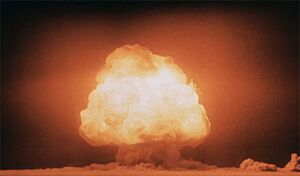
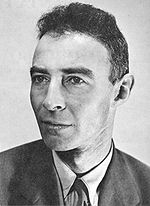
هناك ثلاثة انواع رئيسية من الأسلحة النووية وهي:
- الأسلحة النووية الإنشطارية Fission Weapons وتشمل الأنواع الفرعية: قنابل الكتلة الحرجة Critical Mass ، قنابل المواد المخصبة Enriched Materials.
- الأسلحة النووية الإندماجية Fusion Weapons ومن أهم أنواعها: القنابل الهيدروجينية Hydrogen Bombs التي تعرف أيضا بالقنابل النووية الحرارية Thermonuclear Bombs والقنبلة النيوترونية Neutron Bomb.
- الأسلحة النووية التجميعية Combination Methods، وتشمل الأنواع الفرعية: القنابل ذات الإنشطار المصوب Gun-type Fission Weapon ، قنابل الإنشطار ذات الانضغاط الداخلي Implosion Method.
الأسلحة الاندماجية
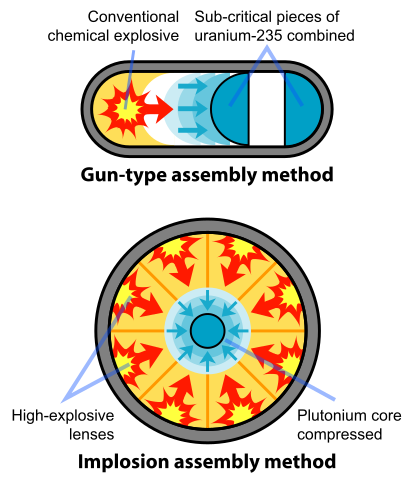
الأسلحة النووية الاندماجية منذ نشوء فكرة خلق كميات هائلة من الطاقة خلال عملية الانشطار النووي أدرك العلماء أن خلق نفس الكمية الهائلة من الطاقة ممكنة من الناحية النظرية والعملية بإجراء عملية معاكسة تماما لعملية الانشطار النووي ألا وهي فكرة اندماج نواتين لذرتين خفيفتي الكتلة في عمليات اندماج متسلسلة تسمى بعملية الاندماج النووي وكانت ذرة الهيدروجين هو الاختيار الأنسب لكونها خفيفة الكتلة.
هناك 3 نظائر للهيدروجين، وهي الديوتريوم deuterium والتريتيوم tritium والپروتيوم protium، وعندما يتحد الديتيريم مع التريتيم يتكون نتيجة لهذا الاندماج ذرة هيليوم ويتكون أثناء هذه العملية طاقة حركية هائلة ولكنها أقل بالمقارنة بعملية الانشطار النووي وتتطلب هذه العمليات الاندماجية كميات كبيرة من الحرارة تصل إلى ملايين الدرجات المئوية ولهذا السبب يطلق تسمية القنابل النووية الحرارية على هذا النوع من الأسلحة النووية.
الأسلحة الانشطارية

يمكن تعريف السلاح النووي الاندماجي بأحد أنواع الأسلحة النووية التي تكمن مصدر قوتها مع عملية الاندماج النووي عندما تتحد أنوية خفيفة الكتلة مثل عنصر الديوتريوم Deuterium وعنصر اللثيوم لتكوين عناصر أثقل من ناحية الكتلة حيث تتم تحفيز سلسلة من عمليات الاتحاد بين هذين العنصرين وتنتج من هذه السلسلة من عمليات الاندماج كميات كبيرة من الطاقة الحركية. ويطلق على القنابل المصنعة بهذه الطريقة اسم القنابل الهيدروجينية H-bombs أو القنابل النووية الحرارية Thermonuclear Bombs لأن سلسلة الاندماج المحفزة بين أنوية هذه العناصر الخفيفة تتطلب كميات كبيرة من الحرارة وتعتبر القنبلة النيوترونية والهيدروجينية من أهم انواع الأسلحة النووية الاندماجية.
جربت هذه النوعية من القنابل لأول مرة عام 1951 م في الولايات المتحدة وكانت هناك مزاعم متبادلة بين الولايات المتحدة والاتحاد السوفيتي حول من توصل إلى تفجير أول القنابل من هذا الطراز حيث تزعم الولايات المتحدة أنها فجرت القنبلة الأولى تجريبيا في 1 نوفمبر 1952 م ثم تلاها الاتحاد السوفيتي في 1 مارس 1954 م وقد خلق الانفجار التجريبي السوفيتي ضجة إعلامية لم يحظى بها الانفجار التجريبي الأمريكي حيث تشكلت سحابة إشعاعية ضخمة فوق سفينة صيد يابانية كانت على بعد 160 كم من موقع الانفجار وقام العلماء اليابانيون بتحليل الغبار على ملابس الصيادين بعد عودتهم وانتشر بعد ذلك خبر امتلاك الاتحاد السوفيتي لهذا النوع من الأسلحة النووية.
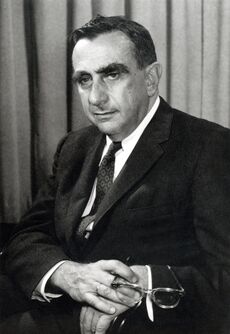
Fusion reactions do not create fission products, and thus contribute far less to the creation of nuclear fallout than fission reactions, but because all thermonuclear weapons contain at least one fission stage, and many high-yield thermonuclear devices have a final fission stage, thermonuclear weapons can generate at least as much nuclear fallout as fission-only weapons. Furthermore, high yield thermonuclear explosions (most dangerously ground bursts) have the force to lift radioactive debris upwards past the tropopause into the stratosphere, where the calm non-turbulent winds permit the debris to travel great distances from the burst, eventually settling and unpredictably contaminating areas far removed from the target of the explosion.
أنواع أخرى
There are other types of nuclear weapons as well. For example, a boosted fission weapon is a fission bomb that increases its explosive yield through a small number of fusion reactions, but it is not a fusion bomb. In the boosted bomb, the neutrons produced by the fusion reactions serve primarily to increase the efficiency of the fission bomb. There are two types of boosted fission bomb: internally boosted, in which a deuterium-tritium mixture is injected into the bomb core, and externally boosted, in which concentric shells of lithium-deuteride and depleted uranium are layered on the outside of the fission bomb core. The external method of boosting enabled the USSR to field the first partially-thermonuclear weapons, but it is now obsolete because it demands a spherical bomb geometry, which was adequate during the 1950s arms race when bomber aircraft were the only available delivery vehicles.
The detonation of any nuclear weapon is accompanied by a blast of neutron radiation. Surrounding a nuclear weapon with suitable materials (such as cobalt or gold) creates a weapon known as a salted bomb. This device can produce exceptionally large quantities of long-lived radioactive contamination. It has been conjectured that such a device could serve as a "doomsday weapon" because such a large quantity of radioactivities with half-lives of decades, lifted into the stratosphere where winds would distribute it around the globe, would make all life on the planet extinct.
In connection with the Strategic Defense Initiative, research into the nuclear pumped laser was conducted under the DOD program Project Excalibur but this did not result in a working weapon. The concept involves the tapping of the energy of an exploding nuclear bomb to power a single-shot laser that is directed at a distant target.
During the Starfish Prime high-altitude nuclear test in 1962, an unexpected effect was produced which is called a nuclear electromagnetic pulse. This is an intense flash of electromagnetic energy produced by a rain of high-energy electrons which in turn are produced by a nuclear bomb's gamma rays. This flash of energy can permanently destroy or disrupt electronic equipment if insufficiently shielded. It has been proposed to use this effect to disable an enemy's military and civilian infrastructure as an adjunct to other nuclear or conventional military operations. By itself it could as well be useful to terrorists for crippling a nation's economic electronics-based infrastructure. Because the effect is most effectively produced by high altitude nuclear detonations (by military weapons delivered by air, though ground bursts also produce EMP effects over a localized area), it can produce damage to electronics over a wide, even continental, geographical area.
Research has been done into the possibility of pure fusion bombs: nuclear weapons that consist of fusion reactions without requiring a fission bomb to initiate them. Such a device might provide a simpler path to thermonuclear weapons than one that required the development of fission weapons first, and pure fusion weapons would create significantly less nuclear fallout than other thermonuclear weapons because they would not disperse fission products. In 1998, the United States Department of Energy divulged that the United States had, "...made a substantial investment" in the past to develop pure fusion weapons, but that, "The U.S. does not have and is not developing a pure fusion weapon", and that, "No credible design for a pure fusion weapon resulted from the DOE investment".[8]
Nuclear isomers provide a possible pathway to fissionless fusion bombs. These are naturally occurring isotopes (178m2Hf being a prominent example) which exist in an elevated energy state. Mechanisms to release this energy as bursts of gamma radiation (as in the hafnium controversy) have been proposed as possible triggers for conventional thermonuclear reactions.
Antimatter, which consists of particles resembling ordinary matter particles in most of their properties but having opposite electric charge, has been considered as a trigger mechanism for nuclear weapons.[9][10][11] A major obstacle is the difficulty of producing antimatter in large enough quantities, and there is no evidence that it is feasible beyond the military domain.[12] However, the U.S. Air Force funded studies of the physics of antimatter in the Cold War, and began considering its possible use in weapons, not just as a trigger, but as the explosive itself.[13] A fourth generation nuclear weapon design[9] is related to, and relies upon, the same principle as antimatter-catalyzed nuclear pulse propulsion.[14]
Most variation in nuclear weapon design is for the purpose of achieving different yields for different situations, and in manipulating design elements to attempt to minimize weapon size,[15] radiation hardness or requirements for special materials, especially fissile fuel or tritium.
. . . . . . . . . . . . . . . . . . . . . . . . . . . . . . . . . . . . . . . . . . . . . . . . . . . . . . . . . . . . . . . . . . . . . . . . . . . . . . . . . . . . . . . . . . . . . . . . . . . . . . . . . . . . . . . . . . . . . . . . . . . . . . . . . . . . . . . . . . . . . . . . . . . . . . . . . . . . . . . . . . . . . . . .
الأسلحة النووية التكتيكية
Some nuclear weapons are designed for special purposes; most of these are for non-strategic (decisively war-winning) purposes and are referred to as Tactical nuclear weapons.
The neutron bomb purportedly conceived by Sam Cohen is a thermonuclear weapon that yields a relatively small explosion but a relatively large amount of neutron radiation. Such a weapon could, according to tacticians, be used to cause massive biological casualties while leaving inanimate infrastructure mostly intact and creating minimal fallout. Because high energy neutrons are capable of penetrating dense matter, such as tank armor, neutron warheads were procured in the 1980s (though not deployed in Europe, as intended, over the objections of NATO allies) for use as tactical payloads for US Army artillery shells (200 mm W79 and 155 mm W82) and short range missile forces. Soviet authorities announced similar intentions for neutron warhead deployment in Europe; indeed claimed to have originally invented the neutron bomb, but their deployment on USSR tactical nuclear forces is unverifiable.
A type of nuclear explosive most suitable for use by ground special forces was the Special Atomic Demolition Munition, or SADM, sometimes popularly known as a suitcase nuke. This is a nuclear bomb that is man-portable, or at least truck-portable, and though of a relatively small yield (one or two kilotons) is sufficient to destroy important tactical targets such as bridges, dams, tunnels, important military or commercial installations, etc. either behind enemy lines or pre-emptively on friendly territory soon to be overtaken by invading enemy forces. These weapons require plutonium fuel and are particularly "dirty". Obviously they also demand especially stringent security precautions in their storage and deployment.
Small "tactical" nuclear weapons were deployed for use as antiaircraft weapons. Examples include the USAF AIR-2 Genie, the AIM-26 Falcon and US Army Nike Hercules. Missile interceptors such as the Sprint and the Spartan also used small nuclear warheads (optimized to produce neutron or X-ray flux) but were for use against enemy strategic warheads.
Other small, or tactical, nuclear weapons were deployed by naval forces for use primarily as antisubmarine weapons. These included nuclear depth bombs or nuclear armed torpedoes. Nuclear mines for use on land or at sea are also possibilities.
الأسلحة النووية حسب البلد
 مقالة مفصلة: قائمة البلدان ذات الأسلحة النووية
مقالة مفصلة: قائمة البلدان ذات الأسلحة النووية
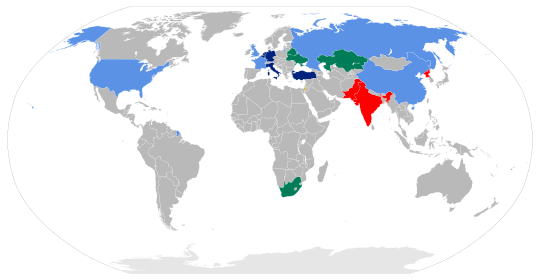
أعلنت ثماني دول ذات سيادة علنًا عن تفجير ناجح لسلاح نووي. [16] هناك خمس دول هي "الدول الحائزة للأسلحة النووية" ((NPT) بموجب شروط معاهدة عدم الانتشار النووي. من أجل الحصول على أسلحة نووية، هذه الدول هي الولايات المتحدة، الاتحاد السوڤيتي (روسيا حالياً) والمملكة المتحدة وفرنسا والصين.
منذ دخول معاهدة حظر الانتشار النووي حيز التنفيذ عام 1970، أجرت ثلاث دول لم تكن أطرافًا في المعاهدة تجارب نووية علنية، وهي الهند، پاكستان، وكوريا الشمالية. كانت كوريا الشمالية طرفًا في معاهدة حظر الانتشار النووي لكنها انسحبت عام 2003.
من المفهوم أيضًا أن إسرائيل تمتلكن أسلحة نووية،[17][18][19][20][21] لكنها لا تعترف بذلك، مع الحفاظ على سياسة الغموض المتعمد، وليس من المعروف بشكل قاطع أنها أجرت تجارب نووية.[22] تشير التقديرات إلى أن إسرائيل تمتلك في مكان ما ما بين 75 و400 رأس نووي.[23][24] أحد الدوافع المحتملة للغموض النووي هو الردع بأقل تكلفة سياسية.[25][26]
الدول التي كانت تمتلك أسلحة نووية هي جنوب أفريقيا (أسلحة نووية مطورة لكنها فككت ترسانتها قبل الانضمام إلى معاهدة عدم انتشار الأسلحة النووية)[27] والجمهوريات السوڤيتية السابقة؛ بلاروسيا، قزخستان، وأوكرانيا، التي سلمت عن أسلحتها لروسيا.
حسب معهد ستوكهولم الدولي لبحوث السلام، اعتباراً من عام 2021 بلغ إجمالي المخزون العالمي للأسلحة النووية 13080، حوالي 30٪ من هؤلاء تم نشرها مع قوات عملياتية،[28] وأكثر من 90٪ مملوكة إما لروسيا أو الولايات المتحدة.[29][30]
| البلد | الرؤوس الحربية[أ]
|
تاريخ أول اختبار
|
موقع أول اختبار
|
وضع CTBT
|
طرق التوصيل
|
الاختبارات
|
ملاحظات
| |
|---|---|---|---|---|---|---|---|---|
| المنتشرة | الإجمالي | |||||||
| الدول الخمس الحائزة للأسلحة النووية بموجب معاهدة عدم انتشار الأسلحة النووية | ||||||||
| 1.357 | 5.550 | 16 يوليو 1945 (ترينتي) | ألاموگوردو، نيو مكسيكو | موقعة [31] | ثالوث نوووي[32] | 1.054 | [33] | |
| 1.456 | 6.257 | 29 أغسطس 1949 (RDS-1) | سميپالاتينسك، قزخستان السوڤيتية | صدقت[31] | ثالوث نووي[34] | 715 | [33] | |
| 120 | 225 | 3 أكتوبر 1952 (الإعصار) | جزر مونتبلو، أستراليا | صدقت [31] | بحري[35][ب] | 45 | [2][36][18] | |
| 280 | 290 | 13 فبراير 1960 (اليربوع الأزرق) | رقان، الجزائر الفرنسية | Ratifier[31] | بحري وجوي [37][ت] | 210 | [2][36] | |
| غير معروف | 350 | 16 October 1964 (596) | Lop Nur, Xinjiang | Signatory[31] | Nuclear triad[38][39] | 45 | [2][36][18] | |
| Non-NPT nuclear powers | ||||||||
| Unknown | 160 | 18 May 1974 (Smiling Buddha) | Pokhran, Rajasthan | Non-signatory[31] | Nuclear triad[40][41][42][43] | 6 | [2][36][18] | |
| 0 | 165 | 28 May 1998 (Chagai-1) | Ras Koh Hills, Balochistan | Non-signatory[31] | Land- and air-based[44][45][ث] | 6 | [2][18] | |
| 0 | 45 | 9 October 2006[47] | Kilju, North Hamgyong | Non-signatory[31] | Land- and sea-based[48][49] | 6 | [2][36][18] | |
| Undeclared nuclear powers | ||||||||
| 0 | 90 | 1960–1979[50][ج] | Unknown | Signatory[31] | Suspected nuclear triad[52][53] | N/A | [2][18] | |
توصيل الأسلحة لأهدافها
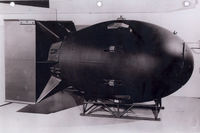
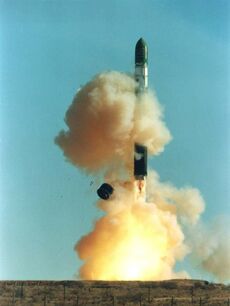
The system used to deliver a nuclear weapon to its target is an important factor affecting both nuclear weapon design and nuclear strategy. The design, development, and maintenance of delivery systems are among the most expensive parts of a nuclear weapons program; they account, for example, for 57% of the financial resources spent by the United States on nuclear weapons projects since 1940.[54]
The simplest method for delivering a nuclear weapon is a gravity bomb dropped from aircraft; this was the method used by the United States against Japan. This method places few restrictions on the size of the weapon. It does, however, limit attack range, response time to an impending attack, and the number of weapons that a country can field at the same time. With miniaturization, nuclear bombs can be delivered by both strategic bombers and tactical fighter-bombers. This method is the primary means of nuclear weapons delivery; the majority of U.S. nuclear warheads, for example, are free-fall gravity bombs, namely the B61.[15][معلومات قديمة]
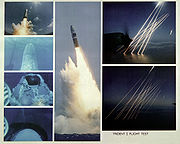
Preferable from a strategic point of view is a nuclear weapon mounted on a missile, which can use a ballistic trajectory to deliver the warhead over the horizon. Although even short-range missiles allow for a faster and less vulnerable attack, the development of long-range intercontinental ballistic missiles (ICBMs) and submarine-launched ballistic missiles (SLBMs) has given some nations the ability to plausibly deliver missiles anywhere on the globe with a high likelihood of success.
More advanced systems, such as multiple independently targetable reentry vehicles (MIRVs), can launch multiple warheads at different targets from one missile, reducing the chance of a successful missile defense. Today, missiles are most common among systems designed for delivery of nuclear weapons. Making a warhead small enough to fit onto a missile, though, can be difficult.[15]
Tactical weapons have involved the most variety of delivery types, including not only gravity bombs and missiles but also artillery shells, land mines, and nuclear depth charges and torpedoes for anti-submarine warfare. An atomic mortar has been tested by the United States. Small, two-man portable tactical weapons (somewhat misleadingly referred to as suitcase bombs), such as the Special Atomic Demolition Munition, have been developed, although the difficulty of combining sufficient yield with portability limits their military utility.[15]
. . . . . . . . . . . . . . . . . . . . . . . . . . . . . . . . . . . . . . . . . . . . . . . . . . . . . . . . . . . . . . . . . . . . . . . . . . . . . . . . . . . . . . . . . . . . . . . . . . . . . . . . . . . . . . . . . . . . . . . . . . . . . . . . . . . . . . . . . . . . . . . . . . . . . . . . . . . . . . . . . . . . . . . .
أنظمة إطلاق الأسلحة النووية
أنظمة إطلاق الصواريخ النووية
انظمة اطلاق الصواريخ النووية هي مجموعة من النظم المستعملة لوضع القنبلة النووية في المكان المراد انفجاره أو بالقرب من الهدف الرئيسي، وهناك مجموعة من الوسائل لتحقيق هذا الغرض منها:
- القنابل الموجهة بتأثير الجاذبية الأرضية وتُعتبر هذه الوسيلة من أقدم الوسائل التي اُستُعمِلَت في تاريخ الأسلحة النووية، وهي الوسيلة التي اُستُعمِلَت في إسقاط القنابل ذات الإنشطار المصوب على مدينة هيروشيما وقنابل الإنشطار ذات الانضغاط الداخلي التي أُلقِيَت على مدينة ناكاساكي حيث كانت هذه القنابل مصممة لتقوم طائرات بإسقاطها على الأهداف المطلوبة أو بالقرب منها.
- الصواريخ الموجهة ذات الرؤوس النووية وهي عبارة عن صواريخ تتبع مساراً محدداً لايمكن الخروج عنه. و تطلق هذه الصواريخ عادة بسرعة يتراوح مقدارها بين 1.1 كم في الثانية إلى 1.3 كم في الثانية وتقسم هذه الصواريخ بصورة عامة إلى صواريخ قصيرة المدى ويصل مداها إلى إقل من 1000 كم ومنها على سبيل المثال صواريخ V-2 الألمانية، وصواريخ سكود السوفيتية، وصواريخ SS-21 الروسية. وهناك أيضا صواريخ متوسطة المدى يصل مداها إلى 2500 - 3500 كم. وأخيرا؛ يوجد هناك الصواريخ العابرة للقارات والتي يصل مداها إلى أكثر من 3500 كم. وتستعمل عادة الصواريخ المتوسطة المدى و العابرة للقارات في تحميل الرؤوس النووية؛ بينما تستعمل الصواريخ القصيرة المدى لاغراض هجومية في المعارك التقليدية. منذ السبعينيات شهد تصنيع الصواريخ الموجهة تطورا كبيرا من ناحية الدقة في اصابة أهدافها.
- صواريخ كروز، وتُسمى ايضا صواريخ توما هوك، تعتبر هذه الصواريخ موجهة وتستعمل أداة إطلاق نفاثة تُمَكِنُ الصاروخ من الطيران لمسافات بعيدة تُقَدَرُ بآلاف الكيلومترات. ومنذ عام 2001 تم التركيز على استعمال هذا النوع من الصواريخ من قبل القوات البحرية الأمريكية وتكلف تصنيع كل صاروخ مايقارب 2 مليون دولار. و تشتمل هذه النوعية من الصواريخ -بدورها- على نوعين؛ نوع قادر على حمل رؤوس نووية، وآخر يحمل فقط رؤوساً حربية تقليدية.
- 'الصواريخ ذات الرؤوس النووية الموجهة من الغواصات في سبتمبر 1955 نجح الاتحاد السوفيتي في إطلاق هذه الصواريخ، وشكلت انعطافة مهمة في مسار الحرب الباردة. تمكنت الولايات المتحدة بعد سنوات عديدة من تصنيع صواريخ مشابهة.
- أنظمة إطلاق أخرى وتشمل استعمال القذائف الدفعية والألغام وقذائف الهاون. وتعتبر هذه الأنواع من أنظمة الاطلاق أصغر الأنظمة حجماً، ويُمكِن تحريكها واستعمالها بسهولة. ومن أشهرها قذائف الهاون الأمريكية المسماة Davy Crockett، والتي صُمِمَت في الخمسينيات وتم تزويد المانيا الغربية بها إبان الحرب الباردة وكانت تحتوي على رأس نووي بقوة 20 طن من مادة تي إن تي. وتم اختبارها في عام 1962 في صحراء نيفادا في الولايات المتحدة.
الاستراتيجية النووية
الحرب النووية الاستراتيجية هي وسيلة لتجنب أي قتال أو حرب نووية. سياسة محاولة لدرء هجوم محتمل من جانب سلاح نووي من بلد آخر من خلال التهديد النووي ردا يعرف استراتيجية الردع النووي. الهدف هو الردع دائما الحفاظ على المركز الثاني في الإضراب (قدرة البلد على الاستجابة لهجوم نووي واحد من مواطنيها) ، وربما السعي إلى الضربة الأولى مركز (تماما القدرة على تدمير العدو / القوات النووية قبل أن يتمكنوا من الرد). خلال الحرب الباردة ، والسياسة والعسكرية النووية المنظرين في تمكين البلدان من نماذج العمل أي نوع من السياسات يمكن أن تحول دون واحد من أي وقت مضى هاجمها سلاح نووي.
أشكال مختلفة من الأسلحة النووية تسليم (أنظر أدناه) لأنواع مختلفة من الاستراتيجية النووية ، في المقام الأول مما يجعل من الصعب للدفاع عنها ، وصعوبة في شن ضربة وقائية ضدها. في بعض الأحيان وهذا يعني الإبقاء على مواقع للأسلحة مخبأة ، مثل وضعه على غواصة ثانية أو القطارات والسيارات والتي هي أماكن من الصعب للغاية بالنسبة لتعقب العدو ، وأحيانا أخرى وهذا يعني دفن في تصلب المستودعات. الردود الأخرى وشملت محاولات لجعله يبدو من المرجح ان البلاد تمكنت من النجاة من هجوم نووي ، وذلك باستخدام الصواريخ الدفاعية (لتدمير الصواريخ قبل الأرض) أو عن طريق الدفاع المدني (باستخدام نظم الإنذار المبكر لإجلاء المواطنين إلى منطقة آمنة قبل الهجوم). علما بأن الاسلحة التي تهدف إلى تهديد كبير من السكان بصفة عامة أو لردع الهجمات وتعرف الأسلحة الاستراتيجية. الأسلحة التي صممت لاستخدامها في الواقع على المعركة العسكرية الميدانية في حالات وتعرف الأسلحة التكتيكية.
هناك نقاد فكرة نووية استراتيجية لشن حرب نووية ممن يعتقدون أن نشوب حرب نووية بين القوتين النوويتين من شأنه أن يؤدي إلى الإفناء المتبادل. من وجهة النظر هذه ، للأسلحة النووية لردع بحت الحرب لأن أي حرب نووية على الفور تصعيد متبادل من الثقة والخوف ، مما يؤدي إلى التدمير المتبادل المؤكد. هذا التهديد الوطنية ، إن لم يكن على الصعيد العالمي ، وتدمير وقد دافع قوي لمكافحة الأسلحة النووية النشاط.
النقاد من حركة السلام وداخل المؤسسة العسكرية وشكك في جدوى مثل هذه الأسلحة في مناخ العسكرية الحالية. استخدام (أو التهديد باستعمالها) مثل هذه الاسلحة مخالف بصورة عامة لقواعد القانون الدولي المطبقة في النزاعات المسلحة ، وفقا لفتوى صادرة عن محكمة العدل الدولية في عام 1996.
ولعل الأكثر إثارة للجدل في الاستراتيجية النووية الفكرة هي أن الانتشار النووي سيكون من المرغوب فيه. هذا الرأي أنه ، على عكس الأسلحة التقليدية ، والأسلحة النووية ، نجحت في ردع حربا شاملة بين الدول ، كما فعلوا خلال الحرب الباردة بين الولايات المتحدة والاتحاد السوفياتي. استاذ العلوم السياسية كينيث الفالز هي ابرز دعاة هذه الحجة.
فقد زعم أن التهديد المحتمل الارهابيين الانتحارية التي تمتلك أسلحة نووية (وهو شكل من أشكال الإرهاب النووي) من تعقيد عملية اتخاذ القرار. التدمير المتبادل المؤكد قد لا تكون فعالة ضد عدو الذي يتوقع ان يلقى حتفه في المواجهة ، لأنها قد تشعر أنها ستكون مكافأة الدينية في الآخرة كما الشهيد المستندات وبالتالي لن تثنيه الشعور بالحفاظ على الذات. وعلاوة على ذلك ، إذا كان الفعل الأولية من المارقة مجموعات من الأفراد بدلا من دولة ، ليست هناك أمة أو ثابت ثابت أهداف عسكرية للانتقام. لقد قيل ، وخصوصا بعد هجمات 11 سبتمبر ايلول 2001 ، وهذا التعقيد هو علامة المقبلة سن النووية الاستراتيجية ، متميزة عن الاستقرار النسبي للحرب الباردة. [55]
According to the Pentagon's June 2019 "Doctrine for Joint Nuclear Operations" of the Joint Chiefs of Staffs website Publication, "Integration of nuclear weapons employment with conventional and special operations forces is essential to the success of any mission or operation."[56][57]
الحوكمة والسيطرة والقانون
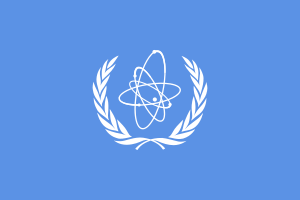
Because they are weapons of mass destruction, the proliferation and possible use of nuclear weapons are important issues in international relations and diplomacy. In most countries, the use of nuclear force can only be authorized by the head of government or head of state.[58] Despite controls and regulations governing nuclear weapons, there is an inherent danger of "accidents, mistakes, false alarms, blackmail, theft, and sabotage".[59]
In the late 1940s, lack of mutual trust prevented the United States and the Soviet Union from making progress on arms control agreements. The Russell–Einstein Manifesto was issued in London on July 9, 1955, by Bertrand Russell in the midst of the Cold War. It highlighted the dangers posed by nuclear weapons and called for world leaders to seek peaceful resolutions to international conflict. The signatories included eleven pre-eminent intellectuals and scientists, including Albert Einstein, who signed it just days before his death on April 18, 1955. A few days after the release, philanthropist Cyrus S. Eaton offered to sponsor a conference—called for in the manifesto—in Pugwash, Nova Scotia, Eaton's birthplace. This conference was to be the first of the Pugwash Conferences on Science and World Affairs, held in July 1957.
By the 1960s, steps were taken to limit both the proliferation of nuclear weapons to other countries and the environmental effects of nuclear testing. The Partial Nuclear Test Ban Treaty (1963) restricted all nuclear testing to underground nuclear testing, to prevent contamination from nuclear fallout, whereas the Treaty on the Non-Proliferation of Nuclear Weapons (1968) attempted to place restrictions on the types of activities signatories could participate in, with the goal of allowing the transference of non-military nuclear technology to member countries without fear of proliferation.
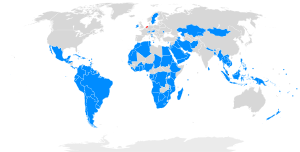
Yes No Did not vote
In 1957, the International Atomic Energy Agency (IAEA) was established under the mandate of the United Nations to encourage development of peaceful applications of nuclear technology, provide international safeguards against its misuse, and facilitate the application of safety measures in its use. In 1996, many nations signed the Comprehensive Nuclear-Test-Ban Treaty,[60] which prohibits all testing of nuclear weapons. A testing ban imposes a significant hindrance to nuclear arms development by any complying country.[61] The Treaty requires the ratification by 44 specific states before it can go into force; اعتبارا من 2012[تحديث], the ratification of eight of these states is still required.[60]
Additional treaties and agreements have governed nuclear weapons stockpiles between the countries with the two largest stockpiles, the United States and the Soviet Union, and later between the United States and Russia. These include treaties such as SALT II (never ratified), START I (expired), INF, START II (never ratified), SORT, and New START, as well as non-binding agreements such as SALT I and the Presidential Nuclear Initiatives[62] of 1991. Even when they did not enter into force, these agreements helped limit and later reduce the numbers and types of nuclear weapons between the United States and the Soviet Union/Russia.
Nuclear weapons have also been opposed by agreements between countries. Many nations have been declared Nuclear-Weapon-Free Zones, areas where nuclear weapons production and deployment are prohibited, through the use of treaties. The Treaty of Tlatelolco (1967) prohibited any production or deployment of nuclear weapons in Latin America and the Caribbean, and the Treaty of Pelindaba (1964) prohibits nuclear weapons in many African countries. As recently as 2006 a Central Asian Nuclear Weapon Free Zone was established among the former Soviet republics of Central Asia prohibiting nuclear weapons.
In 1996, the International Court of Justice, the highest court of the United Nations, issued an Advisory Opinion concerned with the "Legality of the Threat or Use of Nuclear Weapons". The court ruled that the use or threat of use of nuclear weapons would violate various articles of international law, including the Geneva Conventions, the Hague Conventions, the UN Charter, and the Universal Declaration of Human Rights. Given the unique, destructive characteristics of nuclear weapons, the International Committee of the Red Cross calls on States to ensure that these weapons are never used, irrespective of whether they consider them lawful or not.[63]
Additionally, there have been other, specific actions meant to discourage countries from developing nuclear arms. In the wake of the tests by India and Pakistan in 1998, economic sanctions were (temporarily) levied against both countries, though neither were signatories with the Nuclear Non-Proliferation Treaty. One of the stated casus belli for the initiation of the 2003 Iraq War was an accusation by the United States that Iraq was actively pursuing nuclear arms (though this was soon discovered not to be the case as the program had been discontinued). In 1981, Israel had bombed a nuclear reactor being constructed in Osirak, Iraq, in what it called an attempt to halt Iraq's previous nuclear arms ambitions; in 2007, Israel bombed another reactor being constructed in Syria.
In 2013, Mark Diesendorf said that governments of France, India, North Korea, Pakistan, UK, and South Africa have used nuclear power and/or research reactors to assist nuclear weapons development or to contribute to their supplies of nuclear explosives from military reactors.[64]
The two tied-for-lowest points for the Doomsday Clock have been in 1953, when the Clock was set to two minutes until midnight after the U.S. and the Soviet Union began testing hydrogen bombs, and in 2018, following the failure of world leaders to address tensions relating to nuclear weapons and climate change issues.[65]
نزاع الأسلحة النووية
Nuclear disarmament refers to both the act of reducing or eliminating nuclear weapons and to the end state of a nuclear-free world, in which nuclear weapons are eliminated.
Beginning with the 1963 Partial Test Ban Treaty and continuing through the 1996 Comprehensive Nuclear-Test-Ban Treaty, there have been many treaties to limit or reduce nuclear weapons testing and stockpiles. The 1968 Nuclear Non-Proliferation Treaty has as one of its explicit conditions that all signatories must "pursue negotiations in good faith" towards the long-term goal of "complete disarmament". The nuclear-weapon states have largely treated that aspect of the agreement as "decorative" and without force.[66]
Only one country—South Africa—has ever fully renounced nuclear weapons they had independently developed. The former Soviet republics of Belarus, Kazakhstan, and Ukraine returned Soviet nuclear arms stationed in their countries to Russia after the collapse of the USSR.
Proponents of nuclear disarmament say that it would lessen the probability of nuclear war, especially accidentally. Critics of nuclear disarmament say that it would undermine the present nuclear peace and deterrence and would lead to increased global instability. Various American elder statesmen,[67] who were in office during the Cold War period, have been advocating the elimination of nuclear weapons. These officials include Henry Kissinger, George Shultz, Sam Nunn, and William Perry. In January 2010, Lawrence M. Krauss stated that "no issue carries more importance to the long-term health and security of humanity than the effort to reduce, and perhaps one day, rid the world of nuclear weapons".[68]
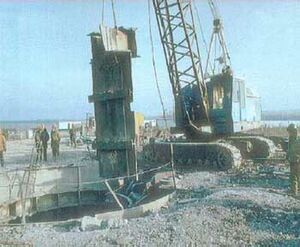
In January 1986, Soviet leader Mikhail Gorbachev publicly proposed a three-stage program for abolishing the world's nuclear weapons by the end of the 20th century.[69] In the years after the end of the Cold War, there have been numerous campaigns to urge the abolition of nuclear weapons, such as that organized by the Global Zero movement, and the goal of a "world without nuclear weapons" was advocated by United States President Barack Obama in an April 2009 speech in Prague.[70] A CNN poll from April 2010 indicated that the American public was nearly evenly split on the issue.[71]
Some analysts have argued that nuclear weapons have made the world relatively safer, with peace through deterrence and through the stability–instability paradox, including in south Asia.[72][73] Kenneth Waltz has argued that nuclear weapons have helped keep an uneasy peace, and further nuclear weapon proliferation might even help avoid the large scale conventional wars that were so common before their invention at the end of World War II.[74] But former Secretary Henry Kissinger says there is a new danger, which cannot be addressed by deterrence: "The classical notion of deterrence was that there was some consequences before which aggressors and evildoers would recoil. In a world of suicide bombers, that calculation doesn’t operate in any comparable way".[75] George Shultz has said, "If you think of the people who are doing suicide attacks, and people like that get a nuclear weapon, they are almost by definition not deterrable".[76]
As of early 2019, more than 90% of world's 13,865 nuclear weapons were owned by Russia and the United States.[77][78]
الأمم المتحدة
The UN Office for Disarmament Affairs (UNODA) is a department of the United Nations Secretariat established in January 1998 as part of the United Nations Secretary-General Kofi Annan's plan to reform the UN as presented in his report to the General Assembly in July 1997.[79]
Its goal is to promote nuclear disarmament and non-proliferation and the strengthening of the disarmament regimes in respect to other weapons of mass destruction, chemical and biological weapons. It also promotes disarmament efforts in the area of conventional weapons, especially land mines and small arms, which are often the weapons of choice in contemporary conflicts.
معاهدات عدم انتشار الأسلحة النووية
برزت منذ الخمسينيات أصوات مناهضة لعمليات الاختبار والتسلح النووي، حيث أُجري منذ 16 يونيو 1945 وحتى 31 ديسمبر 1953 أكثر من خمسين انفجاراً نووياً تجريبياً، مما حدا بالكثير من الشخصيات العالمية إلى التعبير عن رفضها لهذه الأفعال، ومن أبرزها جواهر لال نهرو رئيس وزراء الهند آنذاك والذي دعى إلى التخلي عن إجراء أي اختبارات نووية، دون أن تلقى دعواته آذاناً صاغية من القوى العظمى آنذاك بسبب انهماكها في تفاصيل الحرب الباردة.
بدأت أولى المحاولات للحد من الأسلحة النووية في عام 1963؛ حيث وقعت 135 دولة على اتفاقية سُميت معاهدة الحد الجزئي من الاختبارات النووية وقامت الأمم المتحدة بالإشراف على هذه المعاهدة؛ علماً بأن الصين وفرنسا لم توقعا على هذه المعاهدة وكانتا من الدول ذات الكفاءة النووية.
في عام 1968 تم التوقيع على معاهدة الحد من انتشار الأسلحة النووية، ولكن باكستان والهند وهما دولتان تملكان الأسلحة النووية لم توقعا على هذه المعاهدة، وانسحبت كوريا الشمالية منها في عام 2003.
في 10 سبتمبر 1996 فُتِحَت مُعاهدة جديدة للتوقيع سَميت معاهدة الحد الكلي من إجراء الاختبارات النووية وفيها مُنِع أجراء أي تفجير للقنابل النووية؛ حتى لأغراض سلمية. تم التوقيع على هذه المعاهدة من قبل 71 دولة حتى الآن. لكن لغرض تحويل هذه المعاهدة إلى قرار عملي فإنه يجب ان يصدق عليه من قبل كل الدول الأربع والأربعين التالية: الجزائر والأرجنتين وأستراليا والنمسا وبنغلاديش وبلجيكا والبرازيل وبلغاريا وكندا تشيلي والصين وكولومبيا وكوريا الشمالية وجمهورية الكونغو الديمقراطية ومصر وفنلندا وفرنسا وألمانيا و مجريا والهند وإندونيسيا وإيران وإسرائيل وإيطاليا واليابان و المكسيك و هولندا و النروج و باكستان و پيرو و بولندا و رومانيا وكوريا الجنوبية وروسيا وسلوفاكيا وجنوب إفريقيا وإسبانيا والسويد وسويسرا وتركيا وأوكرانيا والمملكة المتحدة والولايات المتحدة وفيتنام.
إلى هذا اليوم قامت بعض الدول الأربع والأربعين التي يجب أن تُصادِق على المعاهدة بالتوقيع. لم توقع الهند وباكستان وكوريا الشمالية، وقامت دول اخرى بالتوقيع ولكنها لم تتخذ قرارا بالتصديق على المعاهدة؛ وهذه الدول هي الصين وكولومبيا ومصر وإيران وإسرائيل والولايات المتحدة وإندونيسيا وفيتنام. ولا يتوقع ان تقوم اي من هذه الدول بالتصديق على المعاهدة في المستقبل القريب حيث تشهد معظم هذه المناطق توترا سياسيا يحول دون التصديق على هذه المعاهدة.
جدل
الأخلاقيات
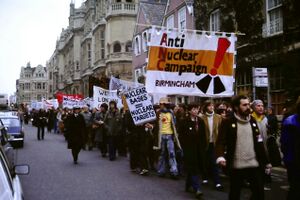
Even before the first nuclear weapons had been developed, scientists involved with the Manhattan Project were divided over the use of the weapon. The role of the two atomic bombings of the country in Japan's surrender and the U.S.'s ethical justification for them has been the subject of scholarly and popular debate for decades. The question of whether nations should have nuclear weapons, or test them, has been continually and nearly universally controversial.[80]
أشهر حوادث الأسلحة النووية
- August 21, 1945: While conducting experiments on a plutonium-gallium core at Los Alamos National Laboratory, physicist Harry Daghlian received a lethal dose of radiation when an error caused it to enter prompt criticality. He died 25 days later, on September 15, 1945, from radiation poisoning.
- May 21, 1946: While conducting further experiments on the same core at Los Alamos National Laboratory, physicist Louis Slotin accidentally caused the core to become briefly supercritical. He received a lethal dose of gamma and neutron radiation, and died nine days later on May 30, 1946. After the death of Daghlian and Slotin, the mass became known as the "demon core." It was ultimately used to construct a bomb for use on the Nevada Test Range.[81]
- February 13, 1950: a Convair B-36B crashed in northern British Columbia after jettisoning a Mark IV atomic bomb. This was the first such nuclear weapon loss in history. The accident was designated a "Broken Arrow"—an accident involving a nuclear weapon but which does not present a risk of war. Experts believe that up to 50 nuclear weapons were lost during the Cold War.[82]
- May 22, 1957: a 42,000-pound (19,000 kg) Mark-17 hydrogen bomb accidentally fell from a bomber near Albuquerque, New Mexico. The detonation of the device's conventional explosives destroyed it on impact and formed a crater 25 feet (7.6 m) in diameter on land owned by the University of New Mexico. According to a researcher at the Natural Resources Defense Council, it was one of the most powerful bombs made to date.[83]
- June 7, 1960: the 1960 Fort Dix IM-99 accident destroyed a Boeing CIM-10 Bomarc nuclear missile and shelter and contaminated the BOMARC Missile Accident Site in New Jersey.
- January 24, 1961: the 1961 Goldsboro B-52 crash occurred near Goldsboro, North Carolina. A Boeing B-52 Stratofortress carrying two Mark 39 nuclear bombs broke up in mid-air, dropping its nuclear payload in the process.[84]
- 1965 Philippine Sea A-4 crash, where a Skyhawk attack aircraft with a nuclear weapon fell into the sea.[85] The pilot, the aircraft, and the B43 nuclear bomb were never recovered.[86] It was not until 1989 that the Pentagon revealed the loss of the one-megaton bomb.[87]
- January 17, 1966: the 1966 Palomares B-52 crash occurred when a B-52G bomber of the USAF collided with a KC-135 tanker during mid-air refuelling off the coast of Spain. The KC-135 was completely destroyed when its fuel load ignited, killing all four crew members. The B-52G broke apart, killing three of the seven crew members aboard.[88] Of the four Mk28 type hydrogen bombs the B-52G carried,[89] three were found on land near Almería, Spain. The non-nuclear explosives in two of the weapons detonated upon impact with the ground, resulting in the contamination of a 2-square-kilometer (490-acre) (0.78 square mile) area by radioactive plutonium. The fourth, which fell into the Mediterranean Sea, was recovered intact after a 2½-month-long search.[90]
- January 21, 1968: the 1968 Thule Air Base B-52 crash involved a United States Air Force (USAF) B-52 bomber. The aircraft was carrying four hydrogen bombs when a cabin fire forced the crew to abandon the aircraft. Six crew members ejected safely, but one who did not have an ejection seat was killed while trying to bail out. The bomber crashed onto sea ice in Greenland, causing the nuclear payload to rupture and disperse, which resulted in widespread radioactive contamination.[91] One of the bombs remains lost.[92]
- September 18–19, 1980: the Damascus Accident, occurred in Damascus, Arkansas, where a Titan missile equipped with a nuclear warhead exploded. The accident was caused by a maintenance man who dropped a socket from a socket wrench down an 80-foot (24 m) shaft, puncturing a fuel tank on the rocket. Leaking fuel resulted in a hypergolic fuel explosion, jettisoning the W-53 warhead beyond the launch site.[93][94][95]
الاختبارات والتداعيات النووية
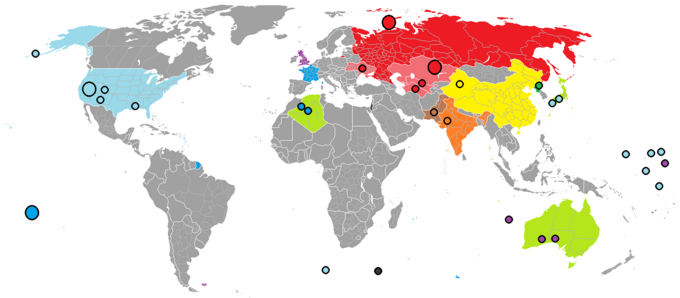
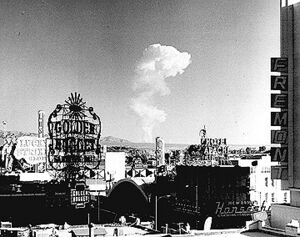
Over 500 atmospheric nuclear weapons tests were conducted at various sites around the world from 1945 to 1980. Radioactive fallout from nuclear weapons testing was first drawn to public attention in 1954 when the Castle Bravo hydrogen bomb test at the Pacific Proving Grounds contaminated the crew and catch of the Japanese fishing boat Lucky Dragon.[96] One of the fishermen died in Japan seven months later, and the fear of contaminated tuna led to a temporary boycotting of the popular staple in Japan. The incident caused widespread concern around the world, especially regarding the effects of nuclear fallout and atmospheric nuclear testing, and "provided a decisive impetus for the emergence of the anti-nuclear weapons movement in many countries".[96]
As public awareness and concern mounted over the possible health hazards associated with exposure to the nuclear fallout, various studies were done to assess the extent of the hazard. A Centers for Disease Control and Prevention/ National Cancer Institute study claims that fallout from atmospheric nuclear tests would lead to perhaps 11,000 excess deaths among people alive during atmospheric testing in the United States from all forms of cancer, including leukemia, from 1951 to well into the 21st century.[97][98] اعتبارا من مارس 2009[تحديث], the U.S. is the only nation that compensates nuclear test victims. Since the Radiation Exposure Compensation Act of 1990, more than $1.38 billion in compensation has been approved. The money is going to people who took part in the tests, notably at the Nevada Test Site, and to others exposed to the radiation.[99][100]
In addition, leakage of byproducts of nuclear weapon production into groundwater has been an ongoing issue, particularly at the Hanford site.[101]
تأثيرات التفجيرات النووية
تأثيرات الأسلحة النووية على الصحة العامة
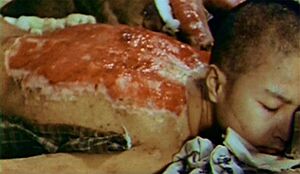
Some scientists estimate that a nuclear war with 100 Hiroshima-size nuclear explosions on cities could cost the lives of tens of millions of people from long-term climatic effects alone. The climatology hypothesis is that if each city firestorms, a great deal of soot could be thrown up into the atmosphere which could blanket the earth, cutting out sunlight for years on end, causing the disruption of food chains, in what is termed a nuclear winter.[102][103]
People near the Hiroshima explosion and who managed to survive the explosion subsequently suffered a variety of medical effects:[104]
- Initial stage—the first 1–9 weeks, in which are the greatest number of deaths, with 90% due to thermal injury and/or blast effects and 10% due to super-lethal radiation exposure.
- Intermediate stage—from 10 to 12 weeks. The deaths in this period are from ionizing radiation in the median lethal range – LD50
- Late period—lasting from 13 to 20 weeks. This period has some improvement in survivors' condition.
- Delayed period—from 20+ weeks. Characterized by numerous complications, mostly related to healing of thermal and mechanical injuries, and if the individual was exposed to a few hundred to a thousand millisieverts of radiation, it is coupled with infertility, sub-fertility and blood disorders. Furthermore, ionizing radiation above a dose of around 50–100 millisievert exposure has been shown to statistically begin increasing one's chance of dying of cancer sometime in their lifetime over the normal unexposed rate of ~25%, in the long term, a heightened rate of cancer, proportional to the dose received, would begin to be observed after ~5+ years, with lesser problems such as eye cataracts and other more minor effects in other organs and tissue also being observed over the long term.
Fallout exposure—depending on if further afield individuals shelter in place or evacuate perpendicular to the direction of the wind, and therefore avoid contact with the fallout plume, and stay there for the days and weeks after the nuclear explosion, their exposure to fallout, and therefore their total dose, will vary. With those who do shelter in place, and or evacuate, experiencing a total dose that would be negligible in comparison to someone who just went about their life as normal.[105][106]
Staying indoors until after the most hazardous fallout isotope, I-131 decays away to 0.1% of its initial quantity after ten half lifes—which is represented by 80 days in I-131s case, would make the difference between likely contracting Thyroid cancer or escaping completely from this substance depending on the actions of the individual.[107]
معارضة العامة
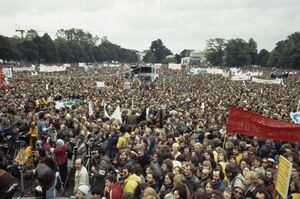
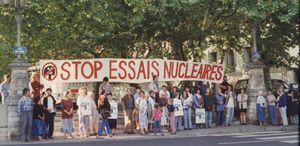
Peace movements emerged in Japan and in 1954 they converged to form a unified "Japan Council against Atomic and Hydrogen Bombs." Japanese opposition to nuclear weapons tests in the Pacific Ocean was widespread, and "an estimated 35 million signatures were collected on petitions calling for bans on nuclear weapons".[108]
In the United Kingdom, the first Aldermaston March organised by the Campaign for Nuclear Disarmament(CND) took place at Easter 1958, when, according to the CND, several thousand people marched for four days from Trafalgar Square, London, to the Atomic Weapons Research Establishment close to Aldermaston in Berkshire, England, to demonstrate their opposition to nuclear weapons.[109][110] The Aldermaston marches continued into the late 1960s when tens of thousands of people took part in the four-day marches.[108]
In 1959, a letter in the Bulletin of the Atomic Scientists was the start of a successful campaign to stop the Atomic Energy Commission dumping radioactive waste in the sea 19 kilometres from Boston.[111] In 1962, Linus Pauling won the Nobel Peace Prize for his work to stop the atmospheric testing of nuclear weapons, and the "Ban the Bomb" movement spread.[80]
In 1963, many countries ratified the Partial Test Ban Treaty prohibiting atmospheric nuclear testing. Radioactive fallout became less of an issue and the anti-nuclear weapons movement went into decline for some years.[96][112] A resurgence of interest occurred amid European and American fears of nuclear war in the 1980s.[113]
التكاليف والتقنيات العرضية
According to an audit by the Brookings Institution, between 1940 and 1996, the U.S. spent $8.63 trillion in present-day terms[114] on nuclear weapons programs. 57 percent of which was spent on building nuclear weapons delivery systems. 6.3 percent of the total, $541 billion in present-day terms, was spent on environmental remediation and nuclear waste management, for example cleaning up the Hanford site, and 7 percent of the total, $606 billion was spent on making nuclear weapons themselves.[115]
الاستخدام السلمي
Peaceful nuclear explosions are nuclear explosions conducted for non-military purposes, such as activities related to economic development including the creation of canals. During the 1960s and 1970s, both the United States and the Soviet Union conducted a number of PNEs. Six of the explosions by the Soviet Union are considered to have been of an applied nature, not just tests.
The United States and the Soviet Union later halted their programs. Definitions and limits are covered in the Peaceful Nuclear Explosions Treaty of 1976.[116][117] The stalled Comprehensive Nuclear-Test-Ban Treaty of 1996 would prohibit all nuclear explosions, regardless of whether they are for peaceful purposes or not.[118]
انظر أيضاً
- Cobalt bomb
- Cosmic bomb (phrase)
- Cuban Missile Crisis
- Dirty bomb
- Induced gamma emission
- List of nuclear close calls
- List of nuclear weapons
- Nth Country Experiment
- Nuclear blackout
- Nuclear bunker buster
- Nuclear holocaust
- Nuclear weapons and the United Kingdom
- Nuclear weapons in popular culture
- Nuclear weapons of the United States
- OPANAL (Agency for the Prohibition of Nuclear Weapons in Latin America and the Caribbean)
- Three Non-Nuclear Principles of Japan
الهوامش
المصادر
- ^ "Frequently Asked Questions #1". Radiation Effects Research Foundation. Archived from the original on September 19, 2007. Retrieved September 18, 2007.
total number of deaths is not known precisely ... acute (within two to four months) deaths ... Hiroshima ... 90,000–166,000 ... Nagasaki ... 60,000–80,000
- ^ أ ب ت ث ج ح خ د "Federation of American Scientists: Status of World Nuclear Forces". Fas.org. Archived from the original on January 2, 2013. Retrieved December 29, 2012.
- ^ "Nuclear Weapons – Israel". Fas.org. January 8, 2007. Archived from the original on December 7, 2010. Retrieved December 15, 2010.
- ^ See also Mordechai Vanunu
- ^ Executive release. "South African nuclear bomb". Nuclear Threat Initiatives. Nuclear Threat Initiatives, South Africa (NTI South Africa). Archived from the original on September 28, 2012. Retrieved March 13, 2012.
- ^ Ian Lowe, "Three minutes to midnight", Australasian Science, March 2016, p. 49.
- ^ Jungk 1958, p. 201.
- ^ U.S. Department of Energy, Restricted Data Declassification Decisions, 1946 to the Present (RDD-8) Archived سبتمبر 24, 2015 at the Wayback Machine (January 1, 2002), accessed November 20, 2011.
- ^ أ ب Gsponer, Andre (2005). "Fourth Generation Nuclear Weapons: Military effectiveness and collateral effects". arXiv:physics/0510071.
- ^ "Details on antimatter triggered fusion bombs". NextBigFuture.com. September 22, 2015. Archived from the original on April 22, 2017.
- ^ "Page discussing the possibility of using antimatter as a trigger for a thermonuclear explosion". Cui.unige.ch. Archived from the original on April 24, 2013. Retrieved May 30, 2013.
- ^ Gsponer, Andre; Hurni, Jean-Pierre (1987). "The physics of antimatter induced fusion and thermonuclear explosions". In Velarde, G.; Minguez, E. (eds.). Proceedings of the 4th International Conference on Emerging Nuclear Energy Systems, Madrid, June 30/July 4, 1986. World Scientific, Singapore. pp. 166–169. arXiv:physics/0507114.
- ^ Keay Davidson; Chronicle Science Writer (October 4, 2004). "Air Force pursuing antimatter weapons: Program was touted publicly, then came official gag order". Sfgate.com. Archived from the original on June 9, 2012. Retrieved May 30, 2013.
- ^ "Fourth Generation Nuclear Weapons". Archived from the original on March 23, 2016. Retrieved October 24, 2014.
- ^ أ ب ت ث خطأ استشهاد: وسم
<ref>غير صحيح؛ لا نص تم توفيره للمراجع المسماةHansen - ^ خطأ استشهاد: وسم
<ref>غير صحيح؛ لا نص تم توفيره للمراجع المسماةNuclearweapons1 - ^ Hersh, Seymour (27 October 1991). "Authors Note". The Samson Option. Random House. ISBN 978-0394570068."This is a book about how Israel became a nuclear power in secret." (First sentence, Authors' Note/Introduction, The Samson Option: Israel's Nuclear Arsenal and American Foreign Policy, Hersh)
- ^ أ ب ت ث ج ح خ "Nuclear Weapons: Who Has What at a Glance". Arms Control Association. July 2019. Retrieved 5 August 2020.
India, Israel, and Pakistan never signed the NPT and possess nuclear arsenals.
- ^ Rosen, Armin (10 November 2014). "Israel's Nuclear Arsenal Might Be Smaller And More Strategic Than Everyone Thinks". Business Insider. Archived from the original on 6 December 2016. Retrieved 16 January 2017.
The country possesses some of the most powerful weaponry on earth, along with delivery systems that give it the ability to strike far beyond its borders.
- ^ "Israel". Nuclear Threat Initiative. May 2015. Archived from the original on 16 January 2017. Retrieved 16 January 2017.
While experts generally agree that Israel possesses nuclear weapons, no such current open source consensus exists on the status of Israel's offensive chemical or biological weapons programs.
- ^ Stover, Dawn (16 September 2016). "Does Israel really have 200 nuclear weapons, or was Colin Powell exaggerating?". Bulletin of the Atomic Scientists. Archived from the original on 18 January 2017. Retrieved 16 January 2017.
The boys in Tehran know Israel has 200, all targeted on Tehran, and we have thousands.
citing primary source private email from Colin Powell to Jeffrey Leeds [1] Archived 16 فبراير 2017 at the Wayback Machine - ^ Harding, Luke (12 December 2006). "Calls for Olmert to resign after nuclear gaffe Israel and the Middle East". The Guardian. London. Retrieved 15 May 2009.
- ^ Nuclear Forces Archived 7 يناير 2015 at the Wayback Machine, Stockholm International Peace Research Institute, sipri.org
- ^ There are a wide range of estimates as to the size of the Israeli nuclear arsenal. For a compiled list of estimates, see Avner Cohen, The Worst-Kept Secret: Israel's bargain with the Bomb (Columbia University Press, 2010), Table 1, page xxvii and page 82.
- ^ خطأ استشهاد: وسم
<ref>غير صحيح؛ لا نص تم توفيره للمراجع المسماةNTIIsrael - ^ Avner Cohen (2010). The Worst-Kept Secret: Israel's bargain with the Bomb. Columbia University Press.
- ^ Arms Control and Global Security, Paul R. Viotti – 2010, p 312
- ^ Ahronheim, Anna (14 June 2021). "SIPRI: Number of fatalities caused by armed conflict falls in 2020". The Jerusalem Post. Retrieved 14 June 2021.
- ^ Reichmann, Kelsey (16 June 2019). "Here's how many nuclear warheads exist, and which countries own them". Defense News.
- ^ "Global Nuclear Arsenal Declines, But Future Cuts Uncertain Amid U.S.-Russia Tensions". Radio Free Europe/Radio Liberty (RFE/RL). 17 June 2019. Archived from the original on 2 July 2019. Retrieved 23 July 2019.
- ^ أ ب ت ث ج ح خ د ذ "Status of Signature and Ratification of the Comprehensive Test Ban Treaty". Archived from the original on 25 September 2011. Retrieved 13 January 2012.
- ^ IISS 2012, pp. 54–55
- ^ أ ب "Nuclear Weapons: Who Has What at a Glance". Arms Control Association. July 2019. Retrieved 5 August 2020.
India, Israel, and Pakistan never signed the NPT and possess nuclear arsenals.
, Last reviewed January 2022. For other credible sources with slightly different numbers and earlier dates, see "FAS World Nuclear Forces". Federation of American Scientists. April 2020. Retrieved 18 June 2020., current date 2021-10-07, and "World Nuclear Forces, SIPRI yearbook 2020". Stockholm International Peace Research Institute. Stockholm International Peace Research Institute. January 2020. Retrieved 18 June 2020., current date: 2020. - ^ IISS 2012, p. 192
- ^ IISS 2012, p. 169
- ^ أ ب ت ث ج "FAS World Nuclear Forces". Federation of American Scientists. April 2020. Retrieved 18 June 2020.
- ^ IISS 2012, p. 111
- ^ The Long Shadow: Nuclear Weapons and Security in 21st Century Asia by Muthiah Alagappa (NUS Press, 2009), page 169: "China has developed strategic nuclear forces made up of land-based missiles, submarine-launched missiles, and bombers. Within this triad, China has also developed weapons of different ranges, capabilities, and survivability."
- ^ IISS 2012, pp. 223–224
- ^ IISS 2012, p. 243
- ^ "Now, India has a nuclear triad". The Hindu. 18 October 2016. Archived from the original on 21 December 2016. Retrieved 24 December 2016.
- ^ Peri, Dinakar (12 June 2014). "India's Nuclear Triad Finally Coming of Age". The Diplomat. Archived from the original on 9 April 2015. Retrieved 10 March 2015.
- ^ "Nuclear triad weapons ready for deployment: DRDO". 7 July 2014. Archived from the original on 2 April 2015. Retrieved 10 March 2015.
- ^ IISS 2012, p. 272
- ^ Pakistan's Nuclear Weapons. Bhumitra Chakma (Routledge 2012), page 61: "Pakistan possesses two types of nuclear delivery vehicles: aircraft and missiles. Initially in the pre-tests era, Islamabad depended solely on aircraft as its chief means of delivering nuclear weapons. In the early 1990s, Pakistan acquired a few dozen ballistic missiles from China, and subsequently, it developed a number of missile systems which became its mainstay of nuclear delivery."
- ^ "Pakistan fires 'first submarine-launched nuclear-capable missile'". Reuters (in الإنجليزية). 10 January 2017. Retrieved 13 May 2020.
- ^ "U.S.: Test Points to N. Korea Nuke Blast". The Washington Post. 13 October 2006. Archived from the original on 27 December 2016. Retrieved 3 September 2017.
- ^ Kristensen, Hans M.; Norris, Robert S. (2 January 2018). "North Korean nuclear capabilities, 2018". Bulletin of the Atomic Scientists (in الإنجليزية). 74 (1): 41–51. Bibcode:2018BuAtS..74a..41K. doi:10.1080/00963402.2017.1413062. ISSN 0096-3402.
- ^ "New North Korean submarine capable of carrying three SLBMs: South Korean MND | NK News – North Korea News" (in الإنجليزية الأمريكية). 31 July 2019. Archived from the original on 4 August 2019. Retrieved 5 August 2019.
- ^ Farr, Warner D (September 1999), The Third Temple's holy of holies: Israel's nuclear weapons, The Counterproliferation Papers, Future Warfare Series 2, USAF Counterproliferation Center, Air War College, Air University, Maxwell Air Force Base, retrieved 2 July 2006.
- ^ *Hersh, Seymour (1991). The Samson option: Israel's Nuclear Arsenal and American Foreign Policy. Random House. ISBN 978-0-394-57006-8., page 271
- ^ An Atlas of Middle Eastern Affairs By Ewan W. Anderson, Liam D. Anderson, (Routledge 2013), page 233: "In terms of delivery systems, there is strong evidence that Israel now possesses all three elements of the nuclear triad."
- ^ IISS 2012, p. 328
- ^ Stephen I. Schwartz, ed., Atomic Audit: The Costs and Consequences of U.S. Nuclear Weapons Since 1940. Washington, D.C.: Brookings Institution Press, 1998. See also Estimated Minimum Incurred Costs of U.S. Nuclear Weapons Programs, 1940–1996, an excerpt from the book. Archived نوفمبر 21, 2008 at the Wayback Machine
- ^ انظر ، على سبيل المثال : فيلدمان ، نوح. "الاسلام والارهاب وعصر نووي ثان" ، مجلة نيويورك تايمز (29 أكتوبر 2006).
- ^ "The Pentagon Revealed Its Nuclear War Strategy and It's Terrifying". Vice. June 21, 2019.
- ^ "Nuclear weapons: experts alarmed by new Pentagon 'war-fighting' doctrine". The Guardian. June 19, 2019.
- ^ In the United States, the President and the Secretary of Defense, acting as the National Command Authority, must jointly authorize the use of nuclear weapons.
- ^ Eric Schlosser, Today's nuclear dilemma, Bulletin of the Atomic Scientists, November/December 2015, vol. 71 no. 6, 11–17.
- ^ أ ب Preparatory Commission for the Comprehensive Nuclear-Test-Ban Treaty Organization (2010). "Status of Signature and Ratification Archived أبريل 6, 2011 at the Wayback Machine". Accessed May 27, 2010. Of the "Annex 2" states whose ratification of the CTBT is required before it enters into force, China, Egypt, Iran, Israel, and the United States have signed but not ratified the Treaty. India, North Korea, and Pakistan have not signed the Treaty.
- ^ Richelson, Jeffrey. Spying on the bomb: American nuclear intelligence from Nazi Germany to Iran and North Korea. New York: Norton, 2006.
- ^ The Presidential Nuclear Initiatives (PNIs) on Tactical Nuclear Weapons At a Glance Archived يناير 19, 2011 at the Wayback Machine, Fact Sheet, Arms Control Association.
- ^ Nuclear weapons and international humanitarian law Archived أبريل 21, 2010 at the Wayback Machine International Committee of the Red Cross
- ^ Mark Diesendorf (2013). "Book review: Contesting the future of nuclear power" (PDF). Energy Policy. Archived from the original (PDF) on September 27, 2013. Retrieved July 9, 2013.[محل شك]
- ^ Koran, Laura (January 25, 2018). "'Doomsday clock' ticks closer to apocalyptic midnight". CNN.
- ^ Gusterson, Hugh, "Finding Article VI Archived سبتمبر 17, 2008 at the Wayback Machine" Bulletin of the Atomic Scientists (January 8, 2007).
- ^ Jim Hoagland (October 6, 2011). "Nuclear energy after Fukushima". The Washington Post. Archived from the original on October 1, 2013.
- ^ Lawrence M. Krauss. The Doomsday Clock Still Ticks, Scientific American, January 2010, p. 26.
- ^ Taubman, William (2017). Gorbachev: His Life and Times. New York City: Simon and Schuster. p. 291. ISBN 978-1-4711-4796-8.
- ^ Graham, Nick (April 5, 2009). "Obama Prague Speech On Nuclear Weapons". Huffingtonpost.com. Archived from the original on May 9, 2013. Retrieved May 30, 2013.
- ^ "CNN Poll: Public divided on eliminating all nuclear weapons". Politicalticker.blogs.cnn.com. April 12, 2010. Archived from the original on July 21, 2013. Retrieved May 30, 2013.
- ^ Krepon, Michael. "The Stability-Instability Paradox, Misperception, and Escalation Control in South Asia" (PDF). Stimson. Archived from the original (PDF) on September 24, 2015. Retrieved November 20, 2015.
- ^ "Michael Krepon • The Stability-Instability Paradox". Archived from the original on January 12, 2015. Retrieved October 24, 2014.
- ^ خطأ استشهاد: وسم
<ref>غير صحيح؛ لا نص تم توفيره للمراجع المسماةwaltz - ^ Ben Goddard (January 27, 2010). "Cold Warriors say no nukes". The Hill. Archived from the original on February 13, 2014.
- ^ Hugh Gusterson (March 30, 2012). "The new abolitionists". Bulletin of the Atomic Scientists. Archived from the original on February 17, 2014. Retrieved February 2, 2014.
- ^ Reichmann, Kelsey (June 16, 2019). "Here's how many nuclear warheads exist, and which countries own them". Defense News.
- ^ "Global Nuclear Arsenal Declines, But Future Cuts Uncertain Amid U.S.-Russia Tensions". Radio Free Europe/Radio Liberty (RFE/RL). June 17, 2019.
- ^ Kofi Annan (July 14, 1997). "Renewing the United Nations: A Program for Reform". United Nations. A/51/950. Archived from the original on March 18, 2017. Retrieved March 17, 2017.
- ^ أ ب Jerry Brown and Rinaldo Brutoco (1997). Profiles in Power: The Anti-nuclear Movement and the Dawn of the Solar Age, Twayne Publishers, pp. 191–192.
- ^ "The Nuclear 'Demon Core' That Killed Two Scientists". April 23, 2018.
- ^ "The Cold War's Missing Atom Bombs". Der Spiegel. November 14, 2008. Archived from the original on June 27, 2019. Retrieved August 20, 2019.
- ^ "Accident Revealed After 29 Years: H-Bomb Fell Near Albuquerque in 1957". Los Angeles Times. Associated Press. August 27, 1986. Archived from the original on September 10, 2014. Retrieved August 31, 2014.
- ^ Barry Schneider (May 1975). "Big Bangs from Little Bombs". Bulletin of the Atomic Scientists. p. 28. Retrieved July 13, 2009.
- ^ "Ticonderoga Cruise Reports". Archived from the original (Navy.mil weblist of Aug 2003 compilation from cruise reports) on September 7, 2004. Retrieved April 20, 2012.
The National Archives hold[s] deck logs for aircraft carriers for the Vietnam Conflict.
- ^ Broken Arrows Archived سبتمبر 1, 2013 at the Wayback Machine at www.atomicarchive.com. Accessed August 24, 2007.
- ^ "U.S. Confirms '65 Loss of H-Bomb Near Japanese Islands". The Washington Post. Reuters. May 9, 1989. p. A–27.
- ^ Hayes, Ron (January 17, 2007). "H-bomb incident crippled pilot's career". Palm Beach Post. Archived from the original on June 16, 2011. Retrieved May 24, 2006.
- ^ Maydew, Randall C. (1997). America's Lost H-Bomb: Palomares, Spain, 1966. Sunflower University Press. ISBN 978-0-89745-214-4.
- ^ Long, Tony (January 17, 2008). "Jan. 17, 1966: H-Bombs Rain Down on a Spanish Fishing Village". WIRED. Archived from the original on December 3, 2008. Retrieved February 16, 2008.
- ^ "The Cold War's Missing Atom Bombs". Der Spiegel. November 14, 2008.
- ^ "US left nuclear weapon under ice in Greenland". The Daily Telegraph. November 11, 2008. Archived from the original on January 10, 2022.
- ^ Schlosser, Eric (2013). Command and Control: Nuclear Weapons, the Damascus Accident, and the Illusion of Safety. Vol. 67. pp. 48–50. Bibcode:2014PhT....67d..48W. doi:10.1063/PT.3.2350. ISBN 978-1-59420-227-8.
{{cite book}}:|journal=ignored (help) - ^ Christ, Mark K. "Titan II Missile Explosion". The Encyclopedia of Arkansas History & Culture. Arkansas Historic Preservation Program. Archived from the original on September 12, 2014. Retrieved August 31, 2014.
- ^ Stumpf, David K. (2000). Christ, Mark K.; Slater, Cathryn H. (eds.). "We Can Neither Confirm Nor Deny" Sentinels of History: Refelections on Arkansas Properties on the National Register of Historic Places. Fayetteville, Arkansas: University of Arkansas Press.
- ^ أ ب ت Rudig, Wolfgang (1990). Anti-nuclear Movements: A World Survey of Opposition to Nuclear Energy. Longman. pp. 54–55. ISBN 978-0582902695.
- ^ "Report on the Health Consequences to the American Population from Nuclear Weapons Tests Conducted by the United States and Other Nations". CDC. Archived from the original on December 4, 2013. Retrieved December 7, 2013.
- ^ Committee to Review the CDC-NCI Feasibility Study of the Health Consequences Nuclear Weapons Tests, National Research Council (2003). Exposure of the American Population to Radioactive Fallout from Nuclear Weapons Tests. doi:10.17226/10621. ISBN 978-0-309-08713-1. PMID 25057651. Archived from the original on September 7, 2014. Retrieved October 24, 2014.
- ^ "What governments offer to victims of nuclear tests". ABC News. Retrieved October 24, 2014.
- ^ "Radiation Exposure Compensation System: Claims to Date Summary of Claims Received by 06/11/2009" (PDF). Archived (PDF) from the original on September 7, 2009.
- ^ Coghlan, Andy. "US nuclear dump is leaking toxic waste". New Scientist. Archived from the original on April 13, 2016. Retrieved March 12, 2016.
- ^ Philip Yam. Nuclear Exchange, Scientific American, June 2010, p. 24.
- ^ Alan Robock and Owen Brian Toon. Local Nuclear War, Global Suffering, Scientific American, January 2010, pp. 74–81.
- ^ "Hiroshima and Nagasaki: The Long Term Health Effects | K=1 Project". k1project.columbia.edu (in الإنجليزية). Archived from the original on June 20, 2017. Retrieved September 7, 2017.
- ^ 7 hour rule: At 7 hours after detonation the fission product activity will have decreased to about 1/10 (10%) of its amount at 1 hour. At about 2 days (49 hours-7X7) the activity will have decreased to 1% of the 1-hour value. Falloutradiation.com Archived أغسطس 31, 2011 at the Wayback Machine
- ^ "Nuclear Warfare" (PDF). p. 22. Archived (PDF) from the original on November 26, 2013.
- ^ Oak Ridge Reservation (USDOE), EPA Facility ID: TN1890090003; Site and Radiological Assessment Branch, Division of Health Assessment and Consultation, Agency for Toxic Substances and Disease Registry. "Public Health Assessment – Iodine-131 Releases" (PDF). atsdr.cdc.gov. U.S. Center for Disease Control. Archived (PDF) from the original on May 11, 2016. Retrieved May 21, 2016.
{{cite web}}: CS1 maint: multiple names: authors list (link) CS1 maint: numeric names: authors list (link) - ^ أ ب Jim Falk (1982). Global Fission: The Battle Over Nuclear Power, Oxford University Press, pp. 96–97.
- ^ "A brief history of CND". Cnduk.org. Archived from the original on June 17, 2004. Retrieved May 30, 2013.
- ^ "Early defections in march to Aldermaston". Guardian Unlimited. London. April 5, 1958. Archived from the original on October 8, 2006.
- ^ Jim Falk (1982). Global Fission: The Battle Over Nuclear Power, Oxford University Press, p. 93.
- ^ Jim Falk (1982). Global Fission: The Battle Over Nuclear Power, Oxford University Press, p. 98.
- ^ Spencer Weart, Nuclear Fear: A History of Images (Cambridge, Massachusetts: Harvard University Press, 1988), chapters 16 and 19.
- ^ Consumer Price Index (estimate) 1800–2008. Federal Reserve Bank of Minneapolis. Retrieved December 7, 2010.
- ^ "Estimated Minimum Incurred Costs of U.S. Nuclear Weapons Programs, 1940–1996". Brookings Institution. Archived from the original on March 5, 2004. Retrieved November 20, 2015.
- ^ "Announcement of Treaty on Underground Nuclear Explosions Peaceful Purposes (PNE Treaty)" (PDF). Gerald R. Ford Museum and Library. May 28, 1976. Archived from the original (PDF) on March 5, 2016. Retrieved February 22, 2016.
- ^ Peters, Gerhard; Woolley, John T. "Gerald R. Ford: "Message to the Senate Transmitting United States-Soviet Treaty and Protocol on the Limitation of Underground Nuclear Explosions," July 29, 1976". The American Presidency Project. University of California – Santa Barbara. Archived from the original on March 3, 2016.
- ^ "Status of Signature and Ratification". ctbto dot org. CTBT Organization Preparatory Commission. Archived from the original on December 28, 2016. Retrieved December 29, 2016.
المراجع
- Bethe, Hans Albrecht. The Road from Los Alamos. New York: Simon and Schuster, 1991. ISBN 0-671-74012-1
- DeVolpi, Alexander, Minkov, Vladimir E., Simonenko, Vadim A., and Stanford, George S. Nuclear Shadowboxing: Contemporary Threats from Cold War Weaponry. Fidlar Doubleday, 2004 (Two volumes, both accessible on Google Book Search) (Content of both volumes is now available in the 2009 trilogy by Alexander DeVolpi: Nuclear Insights: The Cold War Legacy)
- Glasstone, Samuel and Dolan, Philip J. The Effects of Nuclear Weapons (third edition). Washington, D.C.: U.S. Government Printing Office, 1977. Available online (PDF).
- NATO Handbook on the Medical Aspects of NBC Defensive Operations (Part I – Nuclear). Departments of the Army, Navy, and Air Force: Washington, D.C., 1996
- Hansen, Chuck. U.S. Nuclear Weapons: The Secret History. Arlington, TX: Aerofax, 1988
- Hansen, Chuck, "Swords of Armageddon: U.S. nuclear weapons development since 1945" (CD-ROM & download available). PDF. 2,600 pages, Sunnyvale, California, Chucklea Publications, 1995, 2007. ISBN 978-0-9791915-0-3 (2nd Ed.)
- Holloway, David. Stalin and the Bomb. New Haven: Yale University Press, 1994. ISBN 0-300-06056-4
- The Manhattan Engineer District, "The Atomic Bombings of Hiroshima and Nagasaki" (1946)
- (in فرنسية) Jean-Hugues Oppel, Réveillez le président, Éditions Payot et rivages, 2007 (ISBN 978-2-7436-1630-4). The book is a fiction about the nuclear weapons of France; the book also contains about ten chapters on true historical incidents involving nuclear weapons and strategy.
- Smyth, Henry DeWolf. Atomic Energy for Military Purposes. Princeton, NJ: Princeton University Press, 1945. (Smyth Report – the first declassified report by the US government on nuclear weapons)
- The Effects of Nuclear War. Office of Technology Assessment, May 1979.
- Rhodes, Richard. Dark Sun: The Making of the Hydrogen Bomb. New York: Simon and Schuster, 1995. ISBN 0-684-82414-0
- Rhodes, Richard. The Making of the Atomic Bomb. New York: Simon and Schuster, 1986 ISBN 0-684-81378-5
- Shultz, George P. and Goodby, James E. The War that Must Never be Fought, Hoover Press, 2015, ISBN 978-0-8179-1845-3.
- Weart, Spencer R. Nuclear Fear: A History of Images. Cambridge, Massachusetts: Harvard University Press, 1988. ISBN 0-674-62836-5
- Weart, Spencer R. The Rise of Nuclear Fear. Cambridge, Massachusetts: Harvard University Press, 2012. ISBN 0-674-05233-1
قراءات إضافية
| مراجع مكتبية عن سلاح نووي |
- Laura Grego and David Wright, "Broken Shield: Missiles designed to destroy incoming nuclear warheads fail frequently in tests and could increase global risk of mass destruction", Scientific American, vol. 320, no. no. 6 (June 2019), pp. 62–67. "Current U.S. missile defense plans are being driven largely by technology, politics and fear. Missile defenses will not allow us to escape our vulnerability to nuclear weapons. Instead large-scale developments will create barriers to taking real steps toward reducing nuclear risks—by blocking further cuts in nuclear arsenals and potentially spurring new deployments." (p. 67.)
- Michael T. Klare, "Missile Mania: The death of the INF [Intermediate-Range Nuclear Forces] Treaty [of 1987] has escalated the arms race", The Nation, vol. 309, no. 6 (September 23, 2019), p. 4.
- Moniz, Ernest J., and Sam Nunn, "The Return of Doomsday: The New Nuclear Arms Race – and How Washington and Moscow Can Stop It", Foreign Affairs, vol. 98, no. 5 (September / October 2019), pp. 150–161. Former U.S. Secretary of Energy Ernest Moniz and former U.S. Senator Sam Nunn write that "the old [strategic] equilibrium" between the United States and Russia has been "destabilized" by "clashing national interests, insufficient dialogue, eroding arms control structures, advanced missile systems, and new cyberweapons... Unless Washington and Moscow confront these problems now, a major international conflict or nuclear escalation is disturbingly plausible—perhaps even likely." (p. 161.)
- Thomas Powers, "The Nuclear Worrier" (review of Daniel Ellsberg, The Doomsday Machine: Confessions of a Nuclear War Planner, New York, Bloomsbury, 2017, ISBN 9781608196708, 420 pp.), The New York Review of Books, vol. LXV, no. 1 (January 18, 2018), pp. 13–15.
- Eric Schlosser, Command and Control: Nuclear Weapons, the Damascus Accident, and the Illusion of Safety, Penguin Press, 2013, ISBN 1594202273. The book became the basis for a 2-hour 2017 PBS American Experience episode, likewise titled "Command and Control". Nuclear weapons continue to be equally hazardous to their owners as to their potential targets. Under the 1970 Treaty on the Non-Proliferation of Nuclear Weapons, nuclear-weapon states are obliged to work toward the elimination of nuclear weapons.
- David Wright and Cameron Tracy, "Over-hyped: Physics dictates that hypersonic weapons cannot live up to the grand promises made on their behalf", Scientific American, vol. 325, no. 2 (August 2021), pp. 64–71. Quote from p. 71: "Failure to fully assess [the potential benefits and costs of hypersonic weapons] is a recipe for wasteful spending and increased global risk."
وصلات خارجية
- Nuclear Weapon Archive from Carey Sublette is a reliable source of information and has links to other sources and an informative FAQ.
- The Federation of American Scientists provide solid information on weapons of mass destruction, including nuclear weapons and their effects
- Alsos Digital Library for Nuclear Issues – contains many resources related to nuclear weapons, including a historical and technical overview and searchable bibliography of web and print resources.
- Video archive of US, Soviet, UK, Chinese and French Nuclear Weapon Testing at sonicbomb.com
- The National Museum of Nuclear Science & History (United States) – located in Albuquerque, New Mexico; a Smithsonian Affiliate Museum
- Nuclear Emergency and Radiation Resources
- The Manhattan Project: Making the Atomic Bomb at AtomicArchive.com
- Los Alamos National Laboratory: History (U.S. nuclear history)
- Race for the Superbomb, PBS website on the history of the H-bomb
- Recordings of recollections of the victims of Hiroshima and Nagasaki
- The Woodrow Wilson Center's Nuclear Proliferation International History Project or NPIHP is a global network of individuals and institutions engaged in the study of international nuclear history through archival documents, oral history interviews and other empirical sources.
- NUKEMAP3D – a 3D nuclear weapons effects simulator powered by Google Maps.
قالب:United States nuclear devices قالب:French nuclear missiles
قالب:Nuclear and radiation accidents and incidents
خطأ استشهاد: وسوم <ref> موجودة لمجموعة اسمها "lower-alpha"، ولكن لم يتم العثور على وسم <references group="lower-alpha"/>
- CS1 الإنجليزية الأمريكية-language sources (en-us)
- مقالات ذات عبارات محل شك
- CS1 errors: periodical ignored
- CS1 maint: numeric names: authors list
- Articles containing إنگليزية-language text
- Articles with hatnote templates targeting a nonexistent page
- Wikipedia articles in need of updating from يونيو 2013
- مقالات فيها عبارات متقادمة منذ 2012
- جميع المقالات التي فيها عبارات متقادمة
- مقالات فيها عبارات متقادمة منذ مارس 2009
- Articles with فرنسية-language sources (fr)
- مقالات ناطقة
- أسلحة نووية
- اسلحة ومقذوفات طرحت في 1945
- اختراعات أمريكية
- قنابل
- قنابل نووية


